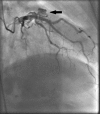Coronary artery fistula draining into pulmonary artery and optimal management: a review
- PMID: 27326064
- PMCID: PMC4832636
- DOI: 10.1136/heartasia-2012-010169
Coronary artery fistula draining into pulmonary artery and optimal management: a review
Abstract
Coronary artery fistula is a rare congenital malformation of high variability. The disease is illustrated with a description of a case example. The management of patients with coronary artery fistulas remains controversial. Both spontaneous regression and life threatening complications have been described. The fistula can be ligated or embolised; however, there are no long term outcome data regarding management. Intraoperative risk of myocardial infarction is less than 5% and death rate varies between 0% and 6%. Due to a small number of cases being described in the literature and a lack of evidence on optimal management, further research is needed in order to determine the best treatment options.
Keywords: cardiac surgery; congenital heart disease; coronary artery disease.
Figures



Similar articles
-
Characteristics of Congenital Coronary Artery Fistulas Complicated with Infective Endocarditis: Analysis of 25 Reported Cases.Congenit Heart Dis. 2016 Dec;11(6):756-765. doi: 10.1111/chd.12392. Epub 2016 Jul 14. Congenit Heart Dis. 2016. PMID: 27414233 Review.
-
[Surgical treatment of coronary artery-pulmonary artery fistula].Nihon Kyobu Geka Gakkai Zasshi. 1993 Sep;41(9):1528-34. Nihon Kyobu Geka Gakkai Zasshi. 1993. PMID: 8409609 Japanese.
-
Transcatheter closure of a congenital coronary artery to right ventricle fistula: a case report.J Med Case Rep. 2014 Dec 16;8:432. doi: 10.1186/1752-1947-8-432. J Med Case Rep. 2014. PMID: 25511876 Free PMC article.
-
[Congenital coronary artery fistulas: clinical and therapeutic consideration].Lijec Vjesn. 2014 Sep-Oct;136(9-10):261-8. Lijec Vjesn. 2014. PMID: 25632771 Croatian.
-
Coronary artery fistulas: clinical and therapeutic considerations.Int J Cardiol. 2006 Feb 8;107(1):7-10. doi: 10.1016/j.ijcard.2005.01.067. Epub 2005 Aug 24. Int J Cardiol. 2006. PMID: 16125261 Review.
Cited by
-
A rare cause of exercise induced ventricular tachycardia.Ann Saudi Med. 2015 May-Jun;35(3):257-9. doi: 10.5144/0256-4947.2015.257. Ann Saudi Med. 2015. PMID: 26409802 Free PMC article.
References
-
- Woo JJ, Koh YY, Ha SI, et al. Non-invasive recognition of generalized coronary arteriosystemic fistulae by contrast echocardiography and multidetector CT. Int J Cardiovasc Imaging 2011;27:749–53. - PubMed
-
- Gowda RM, Vasavada BC, Khan IA. Coronary artery fistulas: clinical and therapeutic considerations. Int J Cardiol 2006;107:7–10. - PubMed
-
- Zenooz NA, Habibi R, Mammen L, et al. Coronary artery fistulas: CT findings. Radiographics 2009;29:781–9. - PubMed
-
- Filizcan U, Ugurlucan M, Zencirci E, et al. Right coronary artery aneurysm with right atrial fistula . J Card Surg 2011;26:381–2. - PubMed
-
- Inoue H, Ueno M, Yamamoto H, et al. Surgical treatment of coronary artery aneurysm with coronary artery fistula. Ann Thorac Cardiovasc Surg 2009;15:198–202. - PubMed
LinkOut - more resources
Full Text Sources
Other Literature Sources
